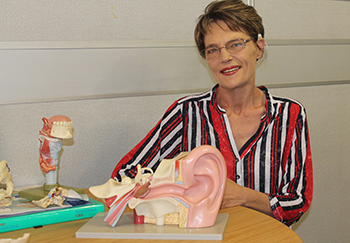
Dr Magteld Smith engages on the topic of hearing loss
and how it coincides with the commemoration of
World Hearing awareness during the month of March.
Photo: Oteng Mpete
Communication is a principal challenge for people with hearing loss. It can be difficult to negotiate everyday interactions, whether in the workplace, on the street, in classrooms, courts, during consultations with health professionals, or even when contacting the police. The World Health Organisation’s (WHO) World Hearing Day is an annual advocacy event held each year on 3 March to raise awareness and promote ear and hearing care across the world. In many countries this awareness campaign usually starts on 3 March but many continue to create awareness for the full month of March.
Hearing loss is a global reality
According to Dr Magteld Smith, a researcher at the University of the Free State (UFS) School of Medicine’s Department of Otorhinolaryngology, unaddressed hearing loss poses a high cost for the economy globally and has a significant impact on the lives of those affected. Interventions to address hearing loss are available in South Africa but are not accessible or affordable for most citizens. This is partly because not only persons with hearing loss but also people with disabilities experience barriers in accessing services that many of us take for granted, including health, education, employment, and transport as well as information. These difficulties are exacerbated in less-advantaged communities.
“WHO estimates that there are more than 360 million persons with hearing loss globally. The statistics in South Africa are unreliable due to the different definitions used by Statistics South Africa and the absence of training of the officials who conduct and collect statistics concerning hearing loss in South Africa,” says Dr Smith.
According to Dr Smith, analysis from retrospective studies reflects that about 17 out of 1 000 infants are born daily in South Africa with severe to profound hearing loss. However, Dr Smith states that the number could be higher because of late diagnosis, high levels of undiagnosed and untreated hearing loss. This excludes young adults, adults and the elderly as well as children with acquired (become deaf after birth) hearing loss.
Crisis that needs urgent intervention
Dr Smith says hearing loss is an emergency which the South African government fails to prioritise. She says that research published confirms that the risk compounding the projected increase in hearing loss that comes with an ageing population. This is a looming and silent public-health crisis.
She believes that the government should take urgent action to align research-spending with the current and projected size and impact of hearing loss. It should also collaborate across related conditions, such as vision, neurodegenerative diseases and neurological conditions. Furthermore, the government needs, and is obligated, to deliver more accessible and integrated services and develop quality standards that take account of the whole pathway – linking public health, clinical and social needs.